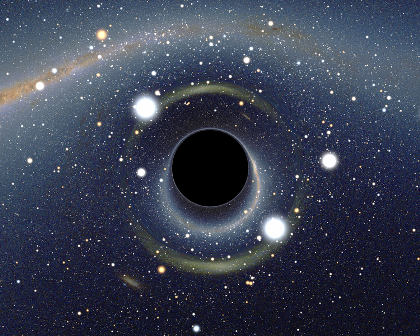One of these following facts about the Black Hole should probably give you much information about the hole. The Black Hole, actually, is a region of spacetime from which gravity prevents anything, including light, from escaping. The theory of general relativity predicts that a sufficiently compact mass will deform spacetime to form a black hole. The boundary of the region from which no escape is possible is called the event horizon. For further information related to this, below are some other facts about the Black Hole you might be interested in.
Facts about the Black Hole 1: Objects
Objects whose gravitational fields are too strong for light to escape were first considered in the 18th century by John Michell and Pierre-Simon Laplace. The first modern solution of general relativity that would characterize a black hole was found by Karl Schwarzchild in 1916, although its interpretation as a region of space from which nothing can escape was first published by David Finkelstein in 1958.
Facts about the Black Hole 2: Theoretical Work
Long considered a mathematical curiosity, it was during the 1960s that theoretical work showed black holes were a generic prediction of general relativity. The discovery of neutron stars sparked interest in gravitationally collapsed compact objects as a possible astrophysical reality.
Facts about the Black Hole 3: Black Holes of Stellar Mass
Black holes of stellar mass are expected to form when very massive stars collapse at the end of their life cycle. After a black hole has formed it can continue to grow by absorbing mass from its surroundings. By absorbing other stars and merging with other black holes, supermassive black holes of millions of solar masses may form.
Facts about the Black Hole 4: Invisible Interior
Despite its invisible interior, the presence of a black hole can be inferred through its interaction with other matter and with electromagnetic radiation such as light. Matter falling onto a black hole can form an accretion disk heated by friction, forming some of the brightest objects in the universe.
Facts about the Black Hole 5: Star Orbit
If there are other stars orbiting a black hole, their orbit can be used to determine its mass and location. Such observations can be used to exclude possible alternatives. In this way, astronomers have identified numerous stellar black hole candidates in binary systems, and established that the core of the Milky Way contains contains a supermassive black hole of about 4.3 million solar masses.
Facts about the Black Hole 6: Stable Condition
The no-hair theorem states that, once the hole achieves a stable condition after formation, a black hole has only three independent physical properties: mass, charge, and angular momentum. Any two black holes that share the same values for these properties, or parameters, are indistinguishable according to classical mechanics.
Facts about the Black Hole 7: Event Horizon
The defining feature of a black hole is the appearance of an event horizon—a boundary in spacetime through which matter and light can only pass inward towards the mass of the black hole. Nothing, not even light, can escape from inside the event horizon. The event horizon is referred to as such because if an event occurs within the boundary, information from that event cannot reach an outside observer, making it impossible to determine if such an event occurred.
Facts about the Black Hole 8: Formation
Considering the exotic nature of black holes, it may be natural to question if such bizarre objects could exist in nature or to suggest that they are merely pathological solutions to Einstein’s equations. Einstein himself wrongly thought that black holes would not form, because he held that the angular momentum of collapsing particles would stabilize their motion at some radius.
Facts about the Black Hole 9: Gravitational Collapse
Gravitational collapse occurs when an object’s internal pressure is insufficient to resist the object’s own gravity. For stars this usually occurs either because a star has too little “fuel” left to maintain its temperature through stellar nuclearsynthesis, or because a star that would have been stable receives extra matter in a way that does not raise its core temperature.
Facts about the Black Hole 10: Observational Evidence
By their very nature, black holes do not directly emit any signals other than the hypothetical Hawking radiation; since the Hawking radiation for an astrophysical black hole is predicted to be very weak, this makes it impossible to directly detect astrophysical black holes from the Earth.
Hope you would find those Black Hole facts really interesting, useful and helpful for your additional reading.









